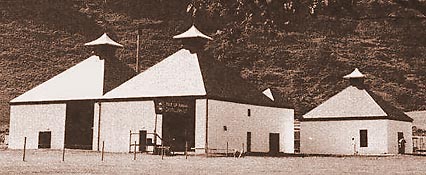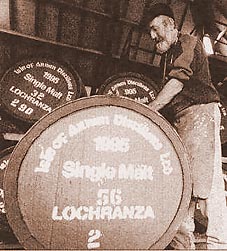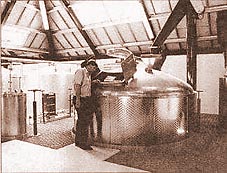
Isle of Arran
A dram come true
Have you ever dreamed of setting up your own distillery? Creating your own malt whisky from scratch? A wonderful, noble, romantic idea, but "between the idea and the reality" - as T.S.Eliot reminds us - "falls the shadow".
The shadow of cost, obviously. The capital outlay for even the smallest distillery operation is enormous (say £1.5 million), and you cannot expect to see any returns from your investment until the spirit is at least three years old - more likely ten years, if you plan to sell it as mature fillings or as a single.
The shadow of quality. How can you know your product will be better than mediocre? What location, equipment, distilling and maturing practices will be most likely to produce outstanding whisky?
The shadow of sales. Who will buy the stuff at the end of the day? The blenders are surely well supplied by existing distilleries? Reaching the consumer of single malt will demand huge advertising and marketing expense?
These are just some of the darker shadows which will have passed over the sunny landscape of Harold Currie's dream to create a new single malt whisky. The fact that he has dispelled them is nothing short of remarkable.
 Against Reason
Against Reason
Mr Currie is an experienced distiller. He has spent his entire working life in the industry, and rose to being a Council Member of the Scotch Whisky Association, Managing Director of Chivas Regal and later of House of Campbell. His bank manager probably thought that he should have known better.
In 1992 a friend with Arran connections suggested the idea of building a distillery there, having been inspired by a talk given to the Arran Society of Glasgow. His reasons were romantically sound: Arran was once famous for its whisky; in the late 18th century "Arran Water", as it was nicknamed, was esteemed as highly as the malts of Glenlivet. Illicit distilling was rife all over the island: there are many tales of heroic battles with Excise officers, one of whom lies in Kilmory kirkyard to this day following an accidental shooting.
The legislation of the early 1820s which encouraged smugglers to "go legal" - and laid the foundations for the modern whisky trade - made little impact on the island, however. The problems of obtaining good barley in sufficient quantity and shipping whisky to the mainland proved insurmountable. Only one distillery took out a license - in 1824, at Lagg in the south-east of the island. It went bust four years later, struggled on for a further seven years and then disappeared.
Harold Currie was initially sceptical. The climate was of closure, not opening distilleries: in 1993 United Distillers had closed four, and Whyte & Mackay were to close a further four two years later. The natural advantages of the island - its interesting location on the edge of the Highlands, mid-way between Lowland Ayrshire, Campbeltown and Islay (what regional character would the whisky have?); the excellence of its water; the fact it is a major tourist destination - were surely outweighed by transport problems.
Raising the WindBut the seed was sewn. Distillery closures were surely a response to the contracting market for blended whisky, particularly at home and in the U.S.; demand at the top end, single malt sector was increasing annually. Family and friends were prepared to invest in the project [in fact the entire cost of building the distillery - some £1.2 million - was found by these investors].
Harold Currie and his sons, Andrew and Paul, who joined him in the venture, then came up with a novel idea for raising working capital and financing initial production: this was to issue "Founder's Bonds". For a single payment of £450, investors secured five cases of Lochranza blended whisky in 1998 and five cases of Isle of Arran single malt in 2001, duty (currently at about £80 per case) to be paid when the whisky leaves the distillery. In the eighteen months the offer was open, Arran Distillery Ltd sold out of its 2,500 available bonds.
 Quality
Assurance
Quality
Assurance
Harold looked at eight sites before he found the perfect source of water, soft and cold and running straight off the hills: the Eason Biorach [literally the "Sharp River"], which rises from a spring in the mountainous north of the island, flows through peat and over red granite, and reaches the sea at Lochranza. Gordon Mitchell, the distillery manager describes it, with typical understatement, as "nice sweet water".
Lochranza is perhaps the prettiest village on Arran. No more than a scattering of houses on the southern side of a deep bay, with steep hills all around and a picturesque ruined castle in its midst. The distillery itself stands some distance from the village, above and to the east of it, commanding fine views of the bay. It has been built from scratch, tastefully designed to fit its site and purpose, with harled walls, slate roofs and copper pagodas. The whole effect is neat and compact.
In his "search for the perfect dram" Harold Currie has favoured the traditional. His four washbacks, are of Oregon pine, made by Browns of Dufftown, as are the feints and spirits receivers. His two stills are small (7,100 litres in the wash still; 4,300 litres the spirit still) and "onion" shaped, with unusually tall necks (16 feet). They are steam-heated by plates and were also made on Speyside, by Forsyths of Rothes. The two warehouses are adjacent to the distillery. Like everything else, they are traditional in style - low, earth-floored, slate-roofed - to take full advantage of Lochranza's damp, windy climate.
They rack four high and hold about 1200 casks each. The distillery is filling a variety of casks - butts, hogsheads and American barrels - to monitor maturation, and has a well-informed wood policy.
Malted barley comes from the Laich o'Moray, and is only slightly peated. The distillery uses 25 tonnes a week, and this is shipped in, ready ground, weekly. It produces about 10,000 litres of alcohol. Gordon Mitchell, the distillery manager, is a Montrose man - indeed, he once managed Lochside Distillery there, before moving to the Republic of Ireland, where he managed Cooley Distillery. He has a staff of only four, augmented by the folk who run the Visitors Centre, which will open next year. Sales and marketing, commercial and financial matters, are master-minded by Harold Currie's sons, Andrew and Paul, from offices in Mauchline, Ayrshire, and Henley-on-Thames.
The Proof of the PuddingBy the early summer last year everything was in place to go into production, and of course, in spite of every care having been taken to ensure high quality spirit, nobody could tell what it would be like.
In June a trial run was done. Jim Murray, the whisky writer, and Jimmy Lang, retired Chief Blender with Chivas Bros. were on hand to nose the new make distillate. Their verdict was: "Quite superb - full of dovetailing complexity and far better than a brand new spirit had any right to be" (Murray); Very well balanced in favourable aromas, and more robust than expected...a delicate pepperiness...sweetness...you are off to a flying start" (Lang). We agree with them. When we tasted the new make at The Vaults early this year, the approval was unanimous and enthusiastic: sweet and full-bodied, with the desirable malt notes which will transform well during maturation; no trace of feints or off-notes; unusually good.
A Flying StartArran Distillery opened formally on 17th August 1995. The opening was attended by almost 1000 people, most of whom had made the sea passage to the island specifically for the occasion. The subsequent support for the venture has been overwhelming: Harold Currie receives daily applications for shares and bonds - neither of which are available - and letters from all over the world expressing interest in the new malt.
It has demanded experience and good judgement to create this new malt whisky. It has also required courage and the support of family and friends. Harold Currie, and everyone else involved in the project, deserve our congratulations: against the odds, if they will pardon the pun, they have made "a dram come true".
Charles Maclean

To visit Arrans own website click here
Unless otherwise noted, all information in this site © The Scotch Malt Whisky Society, Edinburgh, Scotland, 1997.